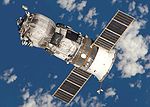TGK PG
| Manufacturer | RSC Energia | ||
|---|---|---|---|
| Country of origin | Russia | ||
| Operator | Roscosmos | ||
| Applications | Space station resupply | ||
| Specifications | |||
| Spacecraft type | Automated cargo spacecraft | ||
| Launch mass | 8,180 kg (18,030 lb) | ||
| Payload capacity | 3,400 kg (7,500 lb) | ||
| Volume | 18 m3 (640 cu ft) | ||
| Production | |||
| Status | Proposal | ||
| Maiden launch | post 2020 (planned) | ||
| Related spacecraft | |||
| Derived from | Progress-MS & Orel | ||
| |||
TGK PG (Russian: Транспортный Грузовой Корабль Повышенной Грузоподъемности (ТГК ПГ), lit. 'Cargo vehicle with increased payload capacity') is an automated cargo spacecraft project to replace Progress-MS as the Russian logistic vehicle to the ISS. It was requested for development to take advantage of the increased lift capacity of the Soyuz-2.1b.[1][2] The initial development contract was awarded to RSC Energia by Roscosmos on December 11, 2015. The spacecraft is not expected to fly before 2020.[3][4]
Spacecraft description
[edit]Born out of the need to reduce the flights to the ISS from 2018 onward, it was designed as a radical departure from the Progress design. It would incorporate concepts and technologies developed from the Orel and Progress-MS projects. One critical characteristic would be a 370 days on-orbit design life, compared to the 210 days of the Progress and Soyuz. This would allow less ships to be launched per year while maintaining a full complement on the station.[3] It would consist of a service module on the aft, an unpressurized propellant cluster of six tanks on the center, a pressurized module with docking adapter on the fore and a truss structure connecting all the parts. It would use the reaction control system of the Progress-MS and an orbital manoeuvring rocket engine already developed for another spacecraft. The new design would have a single deposit of propellant that could be used by the spacecraft or to refuel the space station.[3]
See also
[edit]- Comparison of space station cargo vehicles
- Progress spacecraft – an expendable cargo vehicle currently in use by the Russian Federal Space Agency
- Automated Transfer Vehicle – a retired expendable cargo vehicle used by the ESA
- Cygnus spacecraft – an expendable cargo vehicle developed by Orbital Sciences Corporation under American CRS program, currently in use.
- H-II Transfer Vehicle – a retired expendable cargo vehicle used by JAXA
- Dragon 2 cargo spacecraft - a reusable cargo vehicle developed by SpaceX, under American CRS program, currently in use.
- Dream Chaser Cargo System - a cargo variant of the reusable SNC's spaceplane
References
[edit]- ^ "РКК "Энергия" разрабатывает грузовой космический корабль повышенной грузоподъемности" [RSC Energia to develop cargo spaceship with increased payload] (in Russian). RSC Energia. September 5, 2016. Retrieved 2016-09-05.[dead link]
- ^ "РКК "ЭНЕРГИЯ" РАЗРАБАТЫВАЕТ ГРУЗОВОЙ КОСМИЧЕСКОЙ КОРАБЛЬ ПОВЫШЕННОЙ ГРУЗОПОДЪЕМНОСТИ" [RSC Energia to develop cargo spaceship with increased payload] (in Russian). RSC Energia. September 5, 2016. Archived from the original on 2016-09-06. Retrieved 2016-09-05.
- ^ a b c Zak, Anatoly (September 3, 2016). "Progress cargo ship replacement proposed". RussianSpaceWeb. Retrieved 2016-09-05.
- ^ Zak, Anatoly (August 22, 2016). "A First Peek at Russia's New Space Cargo Ship". Popular Mechanics. Archived from the original on 2016-08-26. Retrieved 2016-09-05.
External links
[edit]
